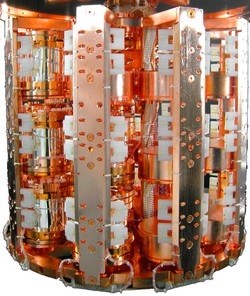CRESST (Cryogenic Rare Event Search with Superconducting Thermometers) is an experiment for the direct search for dark matter. The CRESST experiment is located at LNGS (Laboratori Nazionali del Gran Sasso) an underground laboratory located about 1400 m below the Gran Sasso mountain in Italy.
Currently, there are 18 detector moduls with a mass of about 300 g each installed in the CRESST experiment to search for dark matter and other rare events. The detectors are operated at very low temperatures (about 10 mK) where energy depositions introduced by particle interactions with the detector material (e.g. WIMPs scattering off nuclei) lead to a measurable rise in temperature of the detector.
The detector material used for the CRESST experiment is calcium tungstate (CaWO4) which is a scintillating material, i.e., energy depositions of particles lead to the generation of light as well as a rise in temperature. The amount of scintillation light depends on the type of the incident particle. Electrons generate about 10 times more scintillation light as neutrons for the same energy deposition. This behavior is used to distinguish background events like natural radioactivity or cosmic radiation from possible WIMP interactions.
